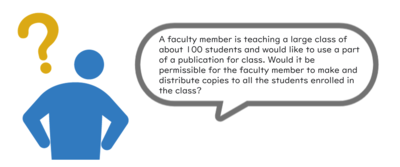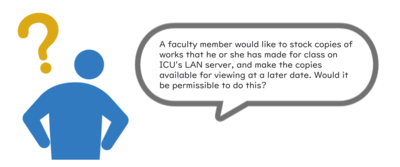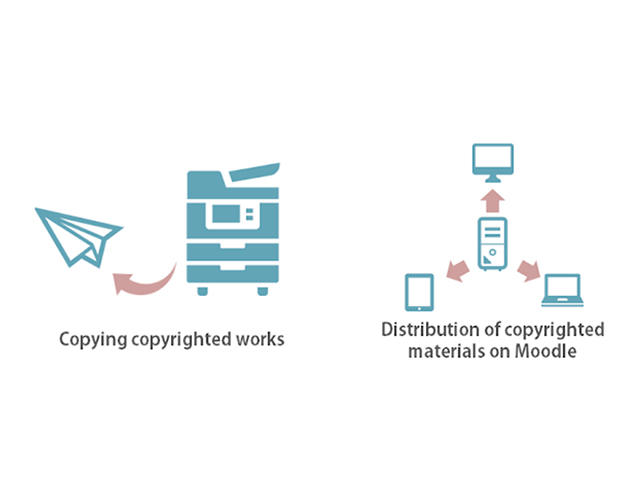Use of works for educational purposes
When we share or distribute course materials in class or upload videos or course materials on Moodle@ICU or on other websites, we need to consider the Copyright Act. If you have any questions about copyright, please feel free to contact the CTL.
◆ New! Amendment of the Copyright Act: Course materials in online classes
-
Release to Recor (Video) Class and Make Recording Public
(Please use this form if you record the guest lecture etc...) - Useful links about copyright and copyright free materials
Educational activities and copyright
Copyright grants the creator of an original work exclusive rights for its use and distribution. The methods of use and distribution that are covered under copyright include reproduction, musical performance, on-screen presentation, broadcast, transmission via the internet (including posting on a website), and rental of a work. In school education, a variety of resources such as publications, literature, websites, music, and videos are used as course materials. When reproducing and distributing copyrighted materials in class or posting videos or resources on Moodle or other websites, we need to consider the copyright of any material we use.
As you may be aware, there are limitations on copyright that allow educational institutions such as universities to exploit a work to the extent that is found to be necessary for teaching and research, without obtaining the authorization of the copyright owner (see for example Article 35 of the Copyright Act). However, the works may be exploited only when “certain conditions” are satisfied. We need to have an accurate understanding of what conditions need to be satisfied, and we need to obtain the authorization of the copyright owner when the exploitation exceeds the permissible range.
We need to pay particular attention when distributing or transmitting a work via the internet. Even in cases where the material exploiting a work can be viewed only by ICU members (e.g., material posted on Moodle or other e-learning platforms, web content, files containing material that were reproduced using a scanner and transmitted), exploitation of the work is considered not only to be “reproduction” but also “making available for transmission” and “public transmission” of the work, and the authorization of the copyright owner of the work would be required.
As a result of the 2018 amendment of the Copyright Act, things that previously could not be done unless the authorization of the copyright owner had been obtained have become possible. It has become possible for each educational institution to publicly transmit a work without obtaining the authorization of the copyright owner by paying compensation, when the exploitation of the work is within a certain scope.
The “Compensation System for Public Transmission for Educational Purposes” came into effect ahead of schedule on April 28, 2020, to respond to the need for remote classes, etc. arising due to COVID-19. (Participation in this scheme was free for FY 2020.) ICU has joined this scheme in 2020, and has also registered for FY 2021.
For details, please see the following page: Amendment of the Copyright Act: Course materials in online classes
| Case Study (1) |
 In this case, when examined against the criterion of “the extent that is found to be necessary”, the action described above may infringe copyright since it constitutes “making a large number of copies and use by a large number of students”. On the other hand, there is a view that, in providing the same education to students enrolled in a class, a judgement should be made taking an integrated approach considering not the number of copies made but the characteristics, extent, manner, etc. of reproduction. Therefore, it is necessary to look at each case on an individual basis. (*As a general rule, the number of copies is usually limited to the sum of the number of students in the class and the number of people teaching the class, and for the number of students in a class, 50 is used as a rough guide. This does not apply to universities but is provided for your reference as a guide.) |
| Case Study (2) |
|
|



